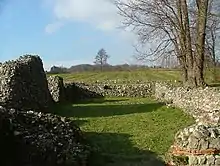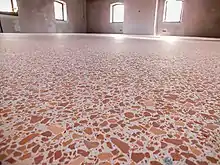Faversham Stone Chapel
Faversham Stone Chapel also known as Our Lady of Elwarton, is a medieval chapel built on top of a Romano-British mausoleum. The chapel is located in what is thought to have been the Roman settlement of Durolevum, near the modern town of Faversham, in Kent, England. It is the only known chapel in England to incorporate the remains of a pagan shrine or mausoleum.[1]

Romano-British construction
Roman Durolevum
Although the site now lies in a rural area on the outskirts of modern Faversham, during Roman times the area was well populated.[1] There was probably a Roman army camp located at Judd Hill, where there is evidence of a large structure (possibly a fort), and where numerous Roman artefacts have been found.[2][3] A Roman cemetery containing the remains of some three hundred and eighty-seven burials is located a few hundred yards east from the church,[3] and a number of Roman coins and other artefacts have been found in the field where the church stands.[1] In 2012, Paul Wilkinson and a team of archeologists discovered and excavated an enormous cockpit-style Roman theatre seating up to 12,000 in Faversham; it is believed to be the first theatre of its kind to be built in Britain.[4] This evidence of Roman occupation has led researchers to believe that Faversham may be the site of Roman Durolevum, mentioned in the Antonine Itinerary.[3]

Roman structure
The Roman building is roughly square, with walls about 17 feet long, and about 3 feet wide.[5] The walls were built using a typically Roman technique, with a flint foundation and layers of tufa blocks, separated by a double layer of red brick and inch thick.[1] The windowless structure had a vaulted roof, and a monolithic door constructed of greensand stone. The cill of the doorway is still in place, while the stones which formed the door frame were reused in the 13th-century medieval buttresses.[1] The floor of the structure was originally opus signinum, a hard waterproof concrete made with broken-down tiles or bricks, giving it a reddish colour. The walls were finished with plaster, which was painted red, and was possibly decorated with frescoes.[5]
The size and nature of the flint foundation suggest that this structure was a Roman mausoleum,[1] though in the absence of burials, this interpretation cannot be confirmed. As there is no villa or cemetery nearby, alternative explanations of the structure are that it was a Romano-Pagan temple or a small Christian Shrine.[5]
Medieval church
After the Roman structure fell into disrepair, it is possible that a timber-built church Saxon church existed on the site. By the medieval era, a flint church was built over the remains of the earlier Roman building, making use of its surviving walls.[5] It is possible that a Saxon church built of wood also existed prior to the building of the medieval church. The medieval builders used the Roman building as the chancel of the church, and the nave was built to the west.[5] The nave and the chancel were expanded in the 13th century, and buttresses were added to the north wall of the nave because wooden beams had rotted.[1] The green sandstone door frames were used in the buttresses, and can still be seen today.[1] The church was reported to be in disrepair by 1511 and seems to be abandoned by 1600.
The chapel is an Ancient Monument managed by The Faversham Society.
References
- "Stone Chapel". faversham.org connect. Archived from the original on 19 January 2012. Retrieved 8 September 2014.
- Rose, J A. "REPORT -- Faversham Archaeological Research Group". Council for Kentish Archaeology. Retrieved 8 September 2014.
- "DVROLEVVM Minor Romano-British Settlement Ospringe, Kent". www.Roman-Britain.org. Archived from the original on 8 July 2013. Retrieved 8 September 2014.
- "Roman theatre discovered in Kent". The Guardian. www.guardian.com. 7 January 2013. Retrieved 9 February 2017.
- "History and Research: Faversham Stone Chapel". www.english-heritage.org.uk. Retrieved 8 September 2014.